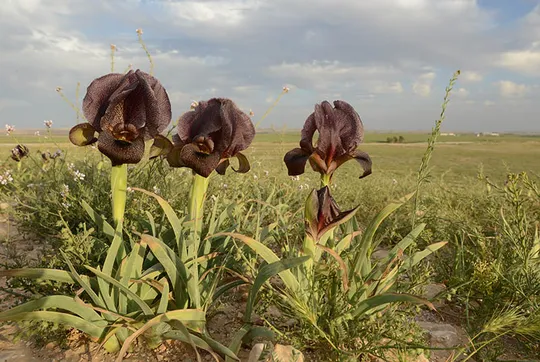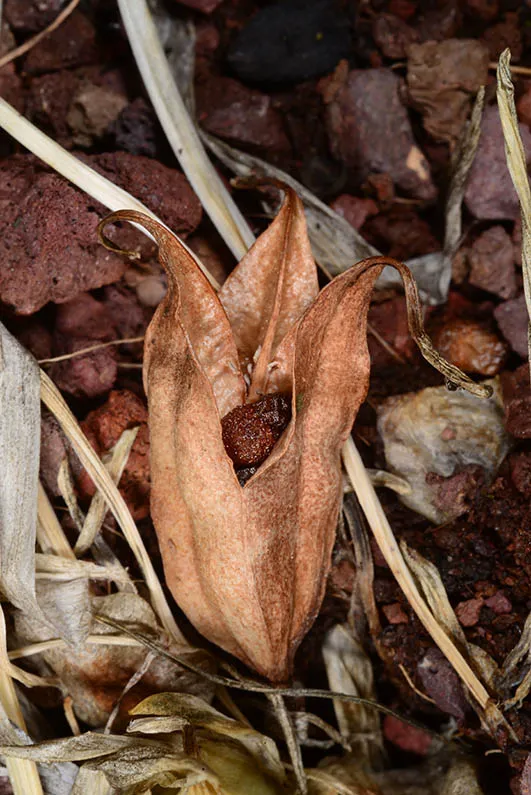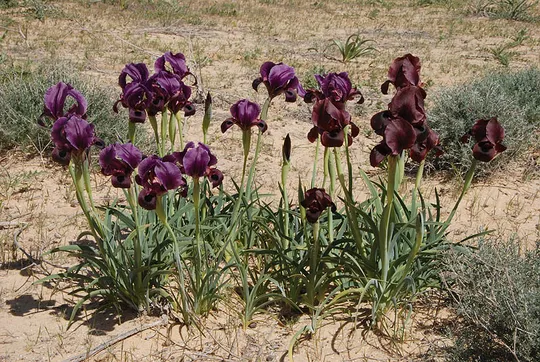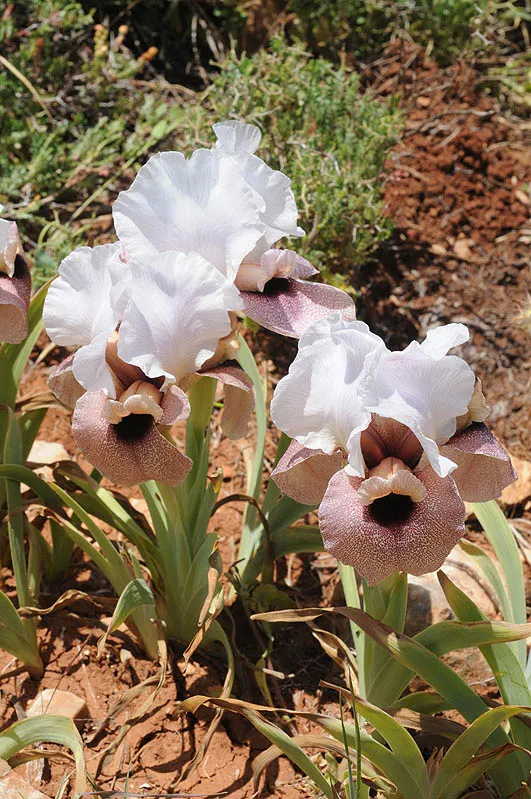Hermon Iris
Iris hermona
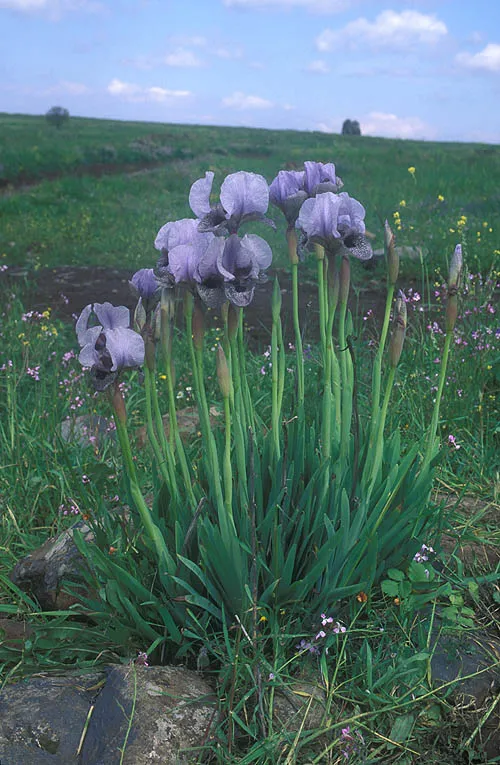
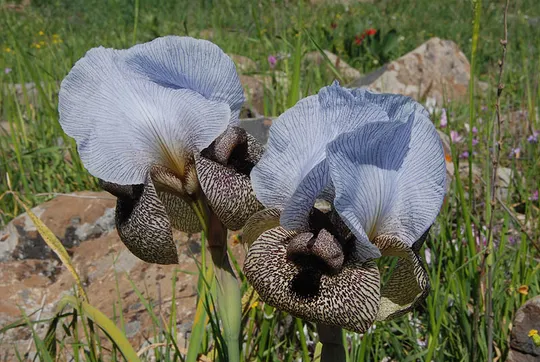
Iris hermona is a geophyte in the Iris section Oncocyclus that grows in clumps. Its bluish pale-green leaves are erect. Each 30-50 cm tall stalk bears a single, large light pinkish-purple flower, 11-16 cm across. The perianth has delicate, parallel netlike lines. The hairs inside the pollination tunnel are purple-black and there are solitary hairs on the standard as well. I. hermona was first discovered in the Quneitra Valley overlooking Mount Hermon, hence its scientific name. In many sources, the common English and Hebrew name Hermon Iris is a translation of the scientific name (Iris hermona), but because this may cause confusion, especially in light of the discovery of two additional iris species on the Hermon itself, we believe that it is more fitting to call it the Golan Iris.
The species grows only in the central Golan and the slopes of Mt. Hermon.
Despite its scientific name (“Iris hermona”), its primary distribution
is in the Golan, and only about 15% of the plants grow on Mt. Hermon. It grows
in the Golan mainly at altitudes above 200 m in the vicinity of the Zavitan
Stream, and up to an altitude of 1000 m at Kunetra and the Bashanit Ridge. The
largest, densest populations grow at altitudes of 500-700 m, between HaMapalim
Junction and the settlement of Keshet, and on to Tanuriya. In the Samakh Stream
basin in the southern Golan, at sea level, there is a miniscule population growing
on chalk. On Mt. Hermon, wild populations grow at altitudes above 1400 m grow
on the Mount Dov and Mount Shalhavit ridges. At the foot of Mt. Hermon to the
west, I. bismarckiana grows, although there is no overlap between the
two species on Mt. Hermon because of the different altitudes at which they
grow. It is possible that the Hermon populations are a transitional form
between I. hermona and I.bismarckiana.
Rocky basalt and heavy basalt soil in the Golan and rocky limestone slopes on
Mt. Hermon.
Iris hermona is a very close species to I. bismarckiana,
but is different from it due to its compact and branchless rhizome and the
short height of its leaf edges relative to its flowering stand.
According to Avishai, the Iris hermona is the missing link
connecting the Iris bismarckiana to the group of species and types
appearing in Syria, Lebanon, Turkey and the Caucasus. Sapir and Matthew raised
the explanation that the hairs on the standards, characteristic of the Regalia
section closely related to the Iris section Oncocyclus, testifies to the
link connecting between these two sections. Avishai presented (and this also
appears in the Flora Palaestina) both of these taxons as separate species,
based on a few morphological differences: leaf width, the pattern and color of
the standards, the shape of the edge of the labellum and especially the
existence of thin root extensions on the Iris bismarckiana and the lack
thereof on the Iris hermona. According to Avishai, there are no hybrids
between them. Despite this, according to Avishai himself and according to Sapir
and personal information, transitions have been founded between the Iris
bismarckiana and the Iris hermona. Rhizome density, the important
distinguishing mark according to Avishai, is a trait with natural variance in
the wild populations. In southern Lebanon (near Ǧezin)
another species was defined – the Iris westii, whose description is
identical to the Iris hermona or the Iris bismarckiana. According
to new testimonies, these populations (of southern Lebanon) were extinct
completely from nature.
·
The plant is attractive for
picking and uprooting. The flowers are huge, and stand on especially tall
stems.
·
The plant was severely
harmed by tanks running them down in the Golan.
·
The populations in the
central Golan between HaMapalim Junction and the Bashanit ridge are numerous
and close to each other.
·
The Hermon populations are
very isolated and separated, as are the Zavitan Stream and the Samakh Stream populations.
·
In the Hermon, the Iris
bismarckiana grows in proximity to the Iris hermona, but in the
Golan, there is no contact between the species.
·
The size of the populations
is stable, and it seems that their density in the Golan is even increasingly
growing since 1967. The Hermon populations are stable.
·
The populations in southern
Lebanon became extinct apparently because of severe pasturing strain and
habitat destruction. Therefore, the populations in Israel are the only ones, or
at least the most important populations, for preservation on a worldwide level.
·
About 20% of the populations
grow in reserves: the Iris Tanuriya Reserve and the Iris Hushniya Reserve
(large populations) and the Yahudiya Reserve (minute populations at the Zavitan
Stream and the Ayit Stream).
The allotment of a
reserve in the central Golan at HaMapalim Junction – Tanuriya – Quneitra
triangle. Monitoring of populations in pasturing areas. Prevention of
development in areas where large populations of the species grow.
Endemic to Israel and perhaps to southern Syria. The data regarding its
distribution in the southern Syria region is unclear. It is based on
correspondence between Professor Feinbrun and Father Muterd, who wrote the
regional flora and claimed that the species also grows in the Bashan up to the
foot of Ǧebel Druz. A survey of all of the populations in
Israel reveals that Iris hermona is more characteristic to the basalts
of the Golan region and less to the Hermon and its calcareous habitat.
Therefore, it is almost certain that Father Muterd was correct, meaning that
this species is perhaps “only” sub-endemic to Israel.
Geophyte from the Iris
section Oncocyclus whose primary distribution is in the Golan
and the Hermon. The species is red because it is endemic and because of the
concern regarding picking and uprooting due to its attractivity. Allotting an
additional central reserve for it in the central Golan region is recommended.
Sapir, Y., Shmida. A, Comes. H.P. (2001) Iris bismarckiana in Israel and Jordan – new findings and taxonomic remarks. Israel Journal of Plant Sciences 49:229–235
Current Occupancy Map
| 1000 squre meter pixel | 5000 squre meter pixel | 10000 squre meter pixel | |
|---|---|---|---|
| number of observations | 0 | 0 | 0 |
| in total pixels | 0 | 0 | 0 |
| Family | Iridaceae |
| Classification | On the endangered species list |
| Ecosystem | Mediterranean and Semi-Steppe |
| Chorotype | Endemic – Eastern Mediterranean |
| Conservation Site | Golan –HaMapalimJunction near Keshet |
| Rarity |
1
2
6
|
|---|---|
| Vulnerability |
0
0
4
|
| Attractiveness |
0
3
4
|
| Endemism |
0
4
4
|
| Red number |
1
4.7
10
|
| Peripherality | 0 |
| IUCN category | DD EW EX LC CR EN VU NT |
| Threat Definition according to the red book | Endangered |
 Based on:
Based on:
